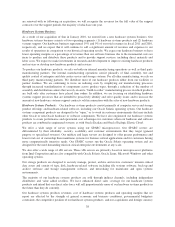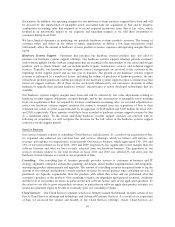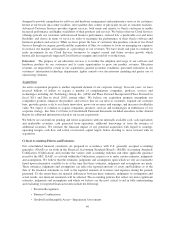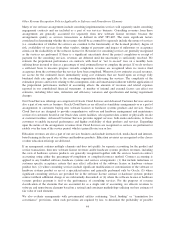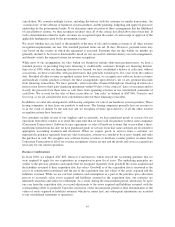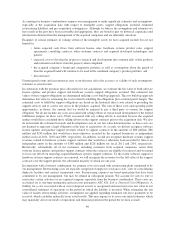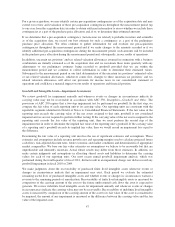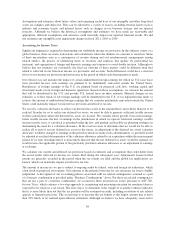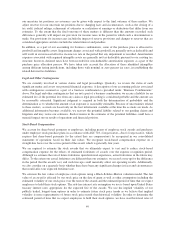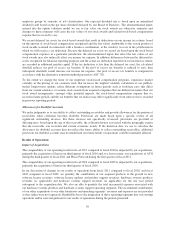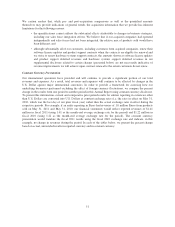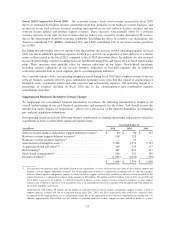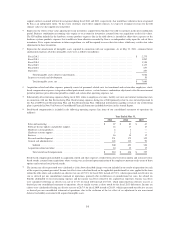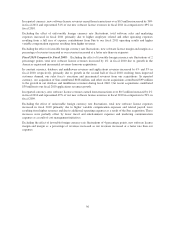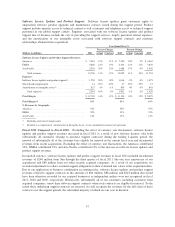Oracle 2011 Annual Report Download - page 49
Download and view the complete annual report
Please find page 49 of the 2011 Oracle annual report below. You can navigate through the pages in the report by either clicking on the pages listed below, or by using the keyword search tool below to find specific information within the annual report.For a given acquisition, we may identify certain pre-acquisition contingencies as of the acquisition date and may
extend our review and evaluation of these pre-acquisition contingencies throughout the measurement period (up
to one year from the acquisition date) in order to obtain sufficient information to assess whether we include these
contingencies as a part of the purchase price allocation and, if so, to determine their estimated amounts.
If we determine that a pre-acquisition contingency (non-income tax related) is probable in nature and estimable
as of the acquisition date, we record our best estimate for such a contingency as a part of the preliminary
purchase price allocation. We often continue to gather information for and evaluate our pre-acquisition
contingencies throughout the measurement period and if we make changes to the amounts recorded or if we
identify additional pre-acquisition contingencies during the measurement period, such amounts will be included
in the purchase price allocation during the measurement period and, subsequently, in our results of operations.
In addition, uncertain tax positions’ and tax related valuation allowances assumed in connection with a business
combination are initially estimated as of the acquisition date and we reevaluate these items quarterly with any
adjustments to our preliminary estimates being recorded to goodwill provided that we are within the
measurement period and we continue to collect information in order to determine their estimated values.
Subsequent to the measurement period or our final determination of the uncertain tax positions’ estimated value
or tax related valuation allowances, whichever comes first, changes to these uncertain tax positions’ and tax
related valuation allowances will affect our provision for income taxes in our consolidated statement of
operations and could have a material impact on our results of operations and financial position.
Goodwill and Intangible Assets—Impairment Assessments
We review goodwill for impairment annually and whenever events or changes in circumstances indicate its
carrying value may not be recoverable in accordance with ASC 350, Intangibles—Goodwill and Other. The
provisions of ASC 350 require that a two-step impairment test be performed on goodwill. In the first step, we
compare the fair value of each reporting unit to its carrying value. Our reporting units are consistent with the
reportable segments identified in Note16 of Notes to Consolidated Financial Statements. If the fair value of the
reporting unit exceeds the carrying value of the net assets assigned to that unit, goodwill is not considered
impaired and we are not required to perform further testing. If the carrying value of the net assets assigned to the
reporting unit exceeds the fair value of the reporting unit, then we must perform the second step of the
impairment test in order to determine the implied fair value of the reporting unit’s goodwill. If the carrying value
of a reporting unit’s goodwill exceeds its implied fair value, then we would record an impairment loss equal to
the difference.
Determining the fair value of a reporting unit involves the use of significant estimates and assumptions. These
estimates and assumptions include revenue growth rates and operating margins used to calculate projected future
cash flows, risk-adjusted discount rates, future economic and market conditions and determination of appropriate
market comparables. We base our fair value estimates on assumptions we believe to be reasonable but that are
unpredictable and inherently uncertain. Actual future results may differ from those estimates. In addition, we
make certain judgments and assumptions in allocating shared assets and liabilities to determine the carrying
values for each of our reporting units. Our most recent annual goodwill impairment analysis, which was
performed during the fourth quarter of fiscal 2011, did not result in an impairment charge, nor did we record any
goodwill impairment in fiscal 2010 or 2009.
We make judgments about the recoverability of purchased finite lived intangible assets whenever events or
changes in circumstances indicate that an impairment may exist. Each period we evaluate the estimated
remaining useful lives of purchased intangible assets and whether events or changes in circumstances warrant a
revision to the remaining periods of amortization. Recoverability of finite lived intangible assets is measured by
comparison of the carrying amount of the asset to the future undiscounted cash flows the asset is expected to
generate. We review indefinite lived intangible assets for impairment annually and whenever events or changes
in circumstances indicate the carrying value may not be recoverable. Recoverability of indefinite lived intangible
assets is measured by comparison of the carrying amount of the asset to its fair value. If the asset is considered to
be impaired, the amount of any impairment is measured as the difference between the carrying value and the fair
value of the impaired asset.
47



